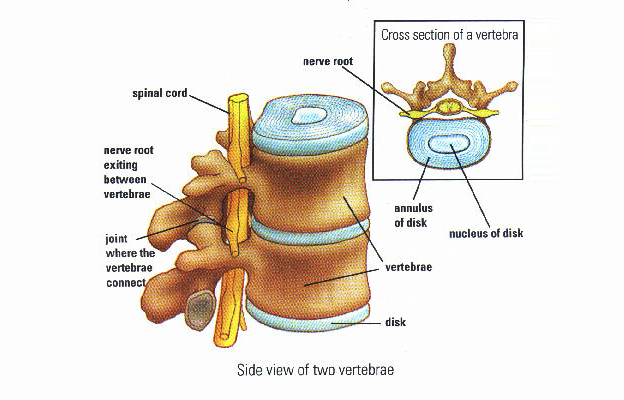Degenerative disc disease is a condition in which the “wear and tear” on your spinal discs begins causing pain. Though everyone will eventually experience some wear and tear on their spinal discs as they grow and age, not everyone will experience degenerative disc disease. It’s important to realize that, though Degenerative Disc Disease is common, it should not be considered normal and can be prevented. Degenerative Disc Disease can be compared to tooth loss in the sense that, in the past, people assumed that losing their teeth was synonymous with aging before they discovered the benefits of preventative dental care and realized that routine dentistry could protect their teeth well into old age! Just like dental care, spinal care and a healthy lifestyle can protect your discs throughout your entire life.
What’s Actually Happening
Your spine is primarily composed of vertebrae and discs, the vertebrae being the bones and the discs being the “cushions” between the bones made up of water, collagen and proteoglycans. These discs serve as shock absorbers between your vertebrae and can vary greatly in size depending on your age, physical activity and hydration levels. When a spinal disc is affected by degenerative disc disease (either because of age, disease, poor posture, poor circulation, etc) the discs between the vertebrae begin to compress which creates less room between the vertebrae in your spine. As a result of this, your natural spinal “shock absorbers” quit working as well, which can then result in pain and discomfort.

Causes of Degenerative Disc Disease
Though Degenerative Disc Disease is commonly (and mistakenly) attributed solely to age, this could not be further from the truth. The primary cause of DDD is joint subluxation (a slight misalignment of the vertebrae) and joint fixation (joints experiencing limited range of motion due to adhesions). Your spinal discs are supplied with water and nutrients via a system called imbibition, a process in which the movement between vertebral discs acts as a pump for fluids to move in and out of your discs. When subluxations or joint fixations are present in your spine, your discs are unable to receive the water and nutrients they require to stay plump and, as a result, they begin to shrink and shorten. Since this process is driven by joint movement, a sedentary lifestyle can make this problem much worse.
Symptoms of Degenerative Disc Disease
Degenerative Disc Disease is most commonly characterized by dull or aching pain around the neck or lower back but can affect any part of the spine. Pain is often made worse by certain physical activities or when your body is held in certain positions. Degenerative Disc Disease usually occurs in “episodes” that can last anywhere from a couple days to multiple weeks. Muscle tension and/or spasms can also occur in varying levels of severity and it’s not uncommon for the pain you’re experiencing to radiate to other parts of the body such as the shoulders, arms, hips or buttocks.
Degenerative Disc Disease Treatment Options
Given that pain reduction is the major goal of Degenerative Disc Disease treatment, your family doctor and/or chiropractor may recommend a combination of different treatment options, such as:
- Ice. Specifically used after physical or strenuous activity, can help reduce inflammation which can reduce the pain you’re experiencing.
- Heat treatments. Heating pads or warm baths may be recommended to help ease the tension of your muscles which can reduce the likeliness of the muscle spasms that often accompany Degenerative Disc Disease.
- Cold Laser Therapy. Cold laser therapy utilizes a handheld device that emits small, non-thermal photons which penetrate through the layers of the skin to the area where you’re experiencing pain. These light rays work to promote healing by stimulating light-sensitive cells causing them to expedite the healing and repair process.
- Chiropractic adjustments. Your chiropractor can gently manipulate the joints in your spine back to their ideal positions which can help restore circulation around the affected disc as well as take unnecessary pressure off of the disc that could be causing pain. By improving your spinal motion, inflammation may be reduced which can relieve discomfort.
- MyACT (Myofascial Acoustic Compression Therapy). MyACT is a machine with a handheld device that delivers precise acoustic waves to your muscles and deep tissues which can increase circulation and provide pain relief from your symptoms. Administered in conjunction with chiropractic adjustments, joint and surrounding muscle function can greatly improve
- Aerobic and strengthening exercises. Since exercising directly promotes healthy circulation and mobility, regular exercise can help improve spinal flexibility, strengthen the back muscles and increase oxygen flow throughout the body.
While these are all common and mild treatments for Degenerative Disc Disease, more serious treatment options are available for severe sufferers, such as:
- Steroid injections. Administered directly into the outermost part of the spine, steroid injections can temporarily relieve pain and improve mobility.
- Artificial disc replacement surgery. This surgical procedure replaces the existing disc with an artificial version typically made of plastic materials which imitate a normal spinal disc.
At HealthFirst Spine & Wellness, our aim is to offer patients relief from the symptoms of degenerative disc disease using an all-natural approach; therefore, we use spinal adjustments, massage therapy, and rehabilitative exercises as a part of our treatment plan for degenerative disc disease. Using these techniques, we improve the strength and flexibility of muscles and relieve pain and muscle weakness associated with this spinal condition. To learn more about our degenerative disc treatment options, request a free consultation today.